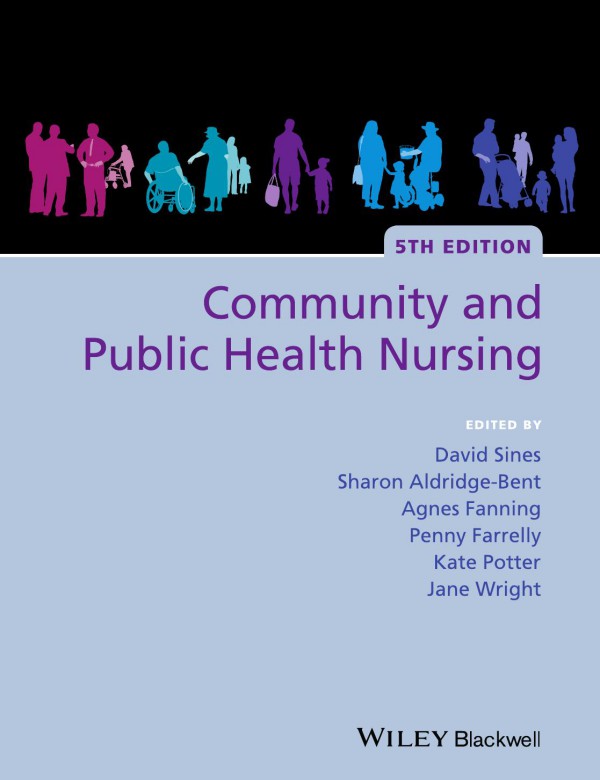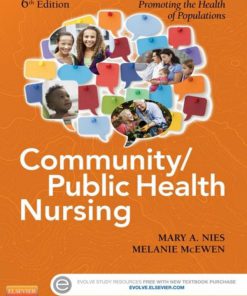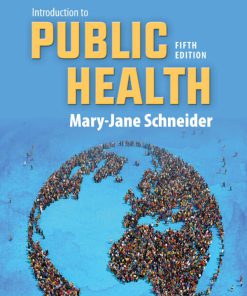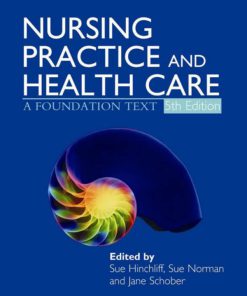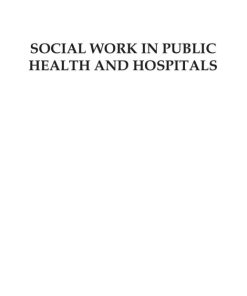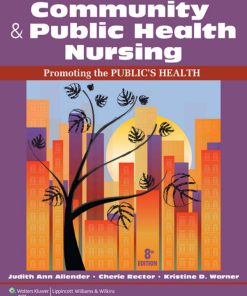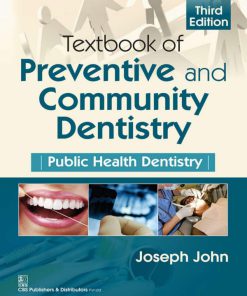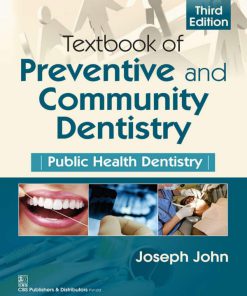Community and Public Health Nursing 5th Edition by David Sines, Sharon Aldridge Bent, Agnes Fanning, Penny Farrelly, Kate Potter, Jane Wright ISBN 9781118426906 1118426908
$50.00 Original price was: $50.00.$25.00Current price is: $25.00.
Authors:David Sines , Author sort:Sines, David , Published:Published:Sep 2013
Community and Public Health Nursing 5th Edition by David Sines, Sharon Aldridge Bent, Agnes Fanning, Penny Farrelly, Kate Potter, Jane Wright – Ebook PDF Instant Download/Delivery. 9781118426906 ,1118426908
Full download Community and Public Health Nursing 5th Edition after payment

Product details:
ISBN 10: 1118426908
ISBN 13: 9781118426906
Author: David Sines, Sharon Aldridge Bent, Agnes Fanning, Penny Farrelly, Kate Potter, Jane Wright
“An extremely popular and valuable resource to students, practitioners and managers in community health care nursing” – Journal of Advanced Nursing
The fifth edition of Community and Public Health Nursing is an essential source of information for all those working in primary and community healthcare. Comprehensive and accessible, it draws on the knowledge of a wide range of experts and conveys all the information and skills nurses working in modern primary care settings require. It includes material on policy developments, research perspectives, health visiting, practice and district nursing, team working, advanced nursing practice, non-medical prescribing, inter-professional practice, and user involvement.
- New edition of the definitive textbook on community healthcare nursing
- Covers learning disability nursing, caring for patients with mental health conditions, and community children’s nursing and school nursing
- Written by experts in the field – providing authority and insight
- Thorough, comprehensive, and up-to-date with the latest policy guidelines
Community and Public Health Nursing is an invaluable resource for novice and experienced practitioners, and for all healthcare professionals who work in the primary care and community setting, including practice nurses, nurse practitioners, district nurses, community staff nurses, health visitors, school nurses, walk-in centre nurses and sexual health nurses.
Community and Public Health Nursing 5th Edition Table of contents:
1 The context of primary healthcare nursing
The changing context of service provision
The changing face of the community healthcare workforce
The primary care vision for the next decade
The impact of primary care policy changes on the role of the primary care nurse
The scope of primary care nursing practice within the context of a changing workforce
Conclusion
References
2 Community Development and Building Capacity
Introduction
The current context for community development practice
Defining the terms
Defining community
Defining social capital
Defining empowerment
Defining capacity building
Defining community development
Defining community engagement
The role of community health professionals
Conclusion
References
3 Multi-Sector Working and Self-Management, Community Health Care
Introduction
Context for multi-sector working in the United Kingdom
Key drivers for multi-agency working
Examples of multi-sector working and self-management initiatives
Dementia
Obesity
Asthma
Concluding reflections
References
4 Moving Care Closer to Home
Hospital provision: A brief history of the last 50 years
Health care: What does it mean?
Selective definitions of health
Universal definitions of health
Caring and nursing: Where are we now?
Nursing at the interface between paid and unpaid care
Public health and care closer to home
Conclusion
References
5 Evidence-Based Practice and Translational Research Applied to Primary Health Care
Introduction
Evidence-based practice
Designing the study
Translational research
Overview
Experiments, randomised controlled trials and quasi-experiments
Health impact assessments
Surveys
Case studies
Different methodologies and methods give you new insights
Participatory approaches for community research
Participatory appraisal
Data collection methods
Data management, analysis and interpretation
A multi-method evaluation of a clinical educational innovation
Example of PA
General research issues
Validity, reliability and generalisability
Presentation and dissemination
The internet or world wide web (www)
Research proposals
Ethical issues
IRAS
The NHS research passport
Ethics committees
Conclusion
Acknowledgments
Further reading
Journals
Ethics
Funding
Statutory body
References
6 Integrating the Children’s Public Health Workforce
Introduction
Health indicators
The policy context
The role of the specialist community public health nurse
The HCP
Delivering the HCP
Pregnancy and the first 5 years of life
The recommended schedule: pregnancy (Universal Services)
The recommended schedule: pregnancy progressive services (Universal Plus and Universal Partnership
The recommended schedule: birth to 6 months (Universal)
The recommended schedule: birth to 6 months (progressive services) (Universal Plus and Universal Par
Recommended schedule: 6 months to 1 year (Universal)
Recommended schedule: 6 months to 1 year (progressive services) (Universal Plus and Universal Partne
Recommended schedule: 1–5 years (Universal Services)
Recommended schedule: 1–5 years (progressive services) (Universal Plus and Universal Partnership
The recommended schedule: 5–11 years (Universal Services)
The recommended schedule: 5–11 years (progressive services) (Universal Plus and Universal Partners
Recommended schedule from 11 to 16 years (Universal Services)
Recommended schedule from 11 to 16 years: progressive services (Universal Plus and Universal Partner
Recommended schedule: 16–19 years (Universal Services)
Recommended schedule: 16–19 years (progressive services) (Universal Plus and Universal Partnershi
The practitioner’s role in safeguarding and child protection
The practitioner role in improving emotional health and well-being
Conclusion: future development and challenges for practice
References
7 Community Children’s Nursing
Introduction
Early days
The NHS
NHS at home: Community children’s nursing services
Children with acute and short-term conditions
Children with LTCs
Children with disabilities and complex conditions, including those requiring continuing care and ne
Technology dependence
Continuing care
Neonates
Children with life-limiting and life-threatening illness, including those requiring palliative and e
Conclusion
References
8 Public Health Nursing (Adult): A Vision for Community Nurses
Introduction
The vision for health reform: the policy context
The public health outcomes framework (2012)
Improving the determinants of health
Health improvements
Health protection
Healthcare public health and preventing premature mortality
Health promotion versus public health
An upstream approach
Health protection
Community nursing and public health
Conclusions: the future
References
9 Caring for the Adult in the Home Setting
End of life
The policy context
Managing LTCs in the community
Case Study based upon complexities of patient care in the home setting
Maximising health and well-being: helping people to stay independent
Working with people to provide a positive experience of care
Adult safeguarding
Measuring impact of service through patient feedback
Delivering high-quality care and measuring impact
Building and strengthening leadership
Ensuring we have the right staff, with the right skills in the right place
Technology
Informal carers
Supporting positive staff experience
Conclusion
References
10 General Practice Nursing in Context
Introduction
Origins
The advent of contemporary general practice nursing
Practice nursing roles and functions
Core skills for the GPN
Education
Scheduled care
Cervical cytology
Immunisations
Wound care
Unscheduled care
Chronic disease management
Asthma management
Hypertension
The future
References
11 Occupational Health Nursing
OHNs as specialist practitioners
Historical perspective
Provision of OH services in the United Kingdom
The changing nature of UK workplaces
Changing work patterns
Workplace practices
The domains of OH nursing practice
The professional domain
The environmental domain
The educational domain of practice
Public health strategies
Specialist community public health nursing: Part 3 of the register maintained by the NMC
References
12 Caring for the Person with Mental Health Needs in the Community
Introduction
Background: Why bother with community mental health nursing?
Clinical profile: John
Recovery: Conceptual explanation
Development of therapeutic relationship
Assessment of needs
Instilling hope
Promoting life beyond distress
Promoting connectedness
Promoting personal responsibility
Principles of community mental health nursing
Examining experience with service users
Linking experiences
Acknowledging service users’ wishes
Working together
Therapeutic presence
Risk assessment and management
Conclusion
References
13 Caring for the Person with Learning Disabilities in the Community
Introduction
People with learning disabilities
The number of people who have learning disabilities
Service principles in learning disability services
Moving forward
The health of people with learning disabilities
Physical health
Mental health
What community nurses for people with learning disabilities do?
The future role of community nursing services for people with learning disabilities
Conclusion
References
14 Leadership: Measuring the Effectiveness of Care Delivery
Introduction
Influences on leadership
Government policies
Front-line staff
Spend some time looking at these four scenarios
Measuring the effectiveness of delivery
Conclusion
References
15 Social Innovation and Enterprise
Introduction
What is social innovation?
Research on social innovation
Characteristics of a social innovator
Social innovation and community health
Commissioning
Approaches to social innovation
Social innovation as a concept
Conclusion
References
16 Adult Vulnerability in the Community
Introduction
Adult safeguarding
Definitions of abuse of adults
Legal framework of adult safeguarding
Mental Capacity Act 2005
Recent adult safeguarding guidance
Domestic violence
The prevalence of domestic violence in the United Kingdom
Effects of domestic violence
Contextual issues
Substance and alcohol misuse
Conclusion
References
17 End-of-life Care
Whole systems approach
Assessment: The foundation to providing good care
Symptom management
Beyond the management of physical symptoms
Advance care planning
Advance statement/Preferred priorities for care
Advanced decisions to refuse treatment (ADRT)
Assisted suicide
Do not attempt resuscitation orders
Care in the last days of life
Models of interdisciplinary working: The road to successful end-of-life care
Community nurses: The lynchpins of successful end-of-life care in the community
Death of a child
Dementia
Care of the bereaved
Conclusion
References
18 Interprofessional Learning and Teaching for Collaborative Practice Community
Introduction
Inter-professional education and collaborative practice
Learning theory
Teaching and learning in practice
Responsibilities for teaching and learning of all members of the team
Team leader
Community practice teacher
Mentor
Associate mentor
Learner
Sign-off mentor
Mastering mentorship
Adult safeguarding: an example
Conclusion
References
19 User Involvement, Self-Management and Compliance
The modern PPI system
The rationale for greater user involvement
The patient as co-producer
Co-production cannot be realised without support
Conclusion
Acknowledgement
References
Index
People also search for Community and Public Health Nursing 5th Edition:
community and public health nutrition 5th edition pdf
community and public health nursing 9th edition pdf
community and public health nursing 3rd edition pdf free
community/public health nursing 7th edition quizlet

